Sonic Translation
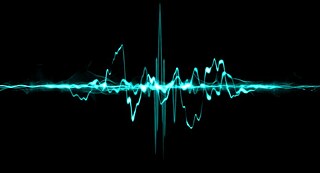
BRINGING THE LOGIC OF ANDERS TO LIFE
When art not only imitates life but vies to replace it, we must be in Hollywood. This is the lesson that Anders relays from his painfully humble years in Southern California and the work in the Hollywood Costume Palace he describes in his diary. But let’s not get ahead of ourselves…Each refugee was different, each exile worked out differently. Some thrived artistically and rose to fame, while Anders’ aesthetic attitudes never generated a liveable income in the City of Angels or during exile. But this time helped lay the foundation for a prolific career as a writer and cultural critic upon his return to Europe in 1950. [Read more about Anders’ time in exile here/Exiled in Hollywood page]
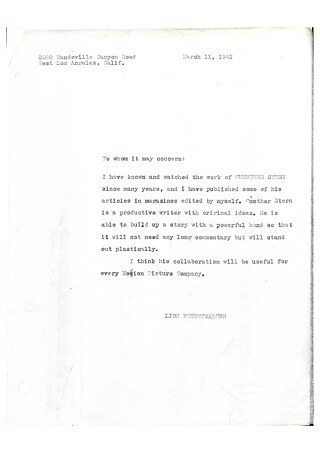
Lion Feuchtwanger's letter of recommendation, dated 11th of March 1941 | © Feuchtwanger Memorial Library, Special Collections, University of Southern California
Today, Anders’ work is known for its uncanny ability to sculpt language into images that communicate complex and emotionally challenging ideas with wit, humour, and apparent ease. In a letter of recommendation to motion picture companies, Lion Feuchtwanger hints at these qualities when noting Anders’ ability to “build up a story...[that] will not need any long commentary but will stand out plastically”. The letter bears the date 11th of March 1941, at which point Anders was already employed in the service of the Hollywood Costume Palace, shaping his experience into the remarkable diary we have adapted into sound.
When Anders first published his diaries in 1967, he introduced them as neither "authentic" biographical accounts nor as historical documents, but as devices that can help expose "the ongoing destruction of the world and of our existence today”, rendering it visible and easy to see. They did not simply seek to record the truth, but were intended to make a greater truth sink in. To aid this process, Anders explains, his diaries needed to be "revised and edited" for publication:
“Who believes that a lump of dough is categorically more real and genuine (echt) than the bread the dough was baked into will probably call them inauthentic (unecht). This does not bother me. I did not see my task in dispensing flour or dough.
Quite the contrary, I only ever recorded experiences or events if these seemed to demand that they still be thought to an end, lived and experienced to an end and articulated to an end.
This means that the retroactive work on these first sketches – their elaboration and alteration – was not an undertaking that was alien to them and was not something that could have made them “false” (unecht).
In fact, it was my belief that only those snapshots managed to prove themselves as legitimate, as "true and genuine" (echt) if you will, if they managed to gain their full truth with the elaboration and alteration they required." (Die Schrift an der Wand, p. 433)
These words by Anders contain the inspiration for our audio adaption of his Hollywood diary. They also contain its guiding logic, for one of the fundamental challenges that any translation needs to navigate is the question of authenticity and accuracy that Anders begins to spell out above.
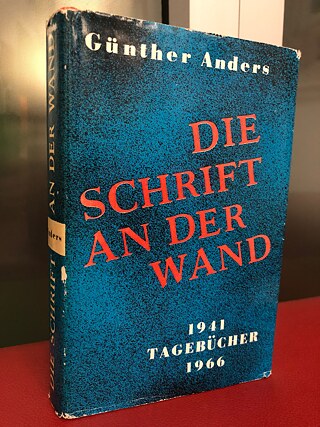
Cover image of the GDR edition of die Schrift an der Wand/The writing on the wall | © Real is Not Real Enough
Should a translation be as accurate as possible, preserve the original syntax and grammatical specificity, or should it try to capture the feel of the text in a manner that allows the intended reader to connect?
In the work of Anders, questions of truth and translation take centre stage. Even in German, his language is strange and different. It relies on idiomatic expressions, wordplay and linguistic trickery that make his work especially hard to translate. Anders also compiled extensive reflections on the effects he envisioned for his unusual use of language. His diaries were evidently part of his quest to find modes of communication that could capture the “wrong ears”, that means people who would usually "listen away". At this, we should add, he had considerable success. (Click here for a detailed discussion of the stylistic innovation that informed Anders’ Hollywood diary) His central work, Die Antiquiertheit des Menschen 1 (1956) [usually translated as: The Obsolescence of Human Beings 1], went on to sell over 80,000 copies in German––a rare feat for a philosophical text.
REAL IS NOT REAL ENOUGH: TRANSLATING THE TRUTH OF ANDERS INTO SOUND
One of the few texts that Anders published in English during exile envisages a device called the "acoustic stereoscope". Published in 1949, “The Acoustic Stereoscope" essay describes how this device is able to sculpt our sonic perception in 3D, giving it acoustic depth by modelling its logic on the visual stereoscope. Instead of showing us a picture of Naples or Calcutta, to use Anders' example, the stereoscope seems to immerse us in these cities.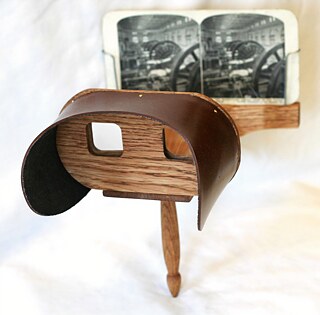
A Holmes visual stereoscope, the most popular from the 19th century stereoscope | © public domain & Dave Pape Department of Media Study The University of Buffalo
“A very simple experiment", he continues, "corroborates that this effect can also be achieved by acoustical means: If you place one radio to your right and one to your left, and have them play the same music simultaneously, it immediately will assume a completely new ‘look’” (“The Acoustic Stereoscope”, p. 240). The trick that Anders describes here is what we today call stereo.
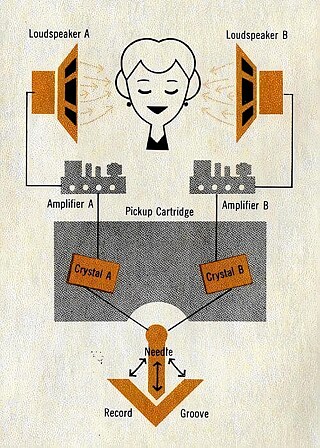
A graphic detail, from an RCA inner sleeve, shows listeners how new stereo technology operates. From the collection of Janet Borgerson, Institute for Business and Professional Ethics, DePaul University and Jonathan Schroeder, William A. Kern, Professor in Communications, Rochester Institute of Technology | © Jonathan Schroeder and Janet Borgerson
A few years later, before stereo started to go commercial, Anders was bemused for not having received due credit. As Reinhard Ellenshohn has relayed (see sources below), Anders was quite serious in his claim to have been the pioneer of the “binaural” principle of stereo. He even expressed his misgivings in a letter to the editor that appeared in 1954 in Der Aufbau/Reconstruction—where he noted that he had sent his article “to leading personalities in the acoustic industry" [führende Persönlichkeiten in der akustischen Industrie"]. Soon after, Anders was credited with the achievement in Der Aufbau (see below).
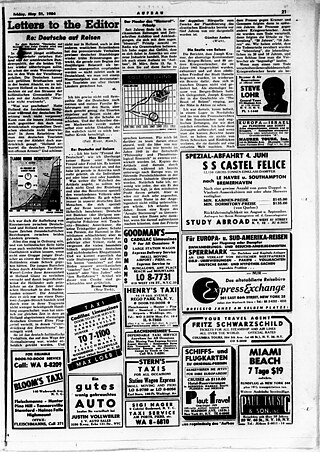
Anders' letter to the editor of Der Aufbau, published May 21st, 1954, noting his contribution to "the acoustic industry" in America | Courtesy of the Leo Baeck Institute, New York © Aufbau Archiv in der JM Jüdische Medien AG, Zürich

Anders being credited by Der Aufbau as the originator of the binaural sound source in a correction published June 1954, responding to a previous story in which Anders was not acknowledged. The editor's response was placed at the bottom of the page next to an advertisement for a popular motion picture, "Ein aufwühlendes Drama" | Courtesy of the Leo Baeck Institute, New York © Aufbau Archiv in der JM Jüdischen Medien AG, Zürich
The below television advert for living stereo from 1958 would no doubt have added insult to injury. It introduced the stereo record player as “nothing short of a miracle” and “dramatically new”, “made possible only through years of research, inventions, and innovations", and it visually demonstrates how the arrangement of speakers that Anders envisaged was being celebrated for its highly immersive effect. For the key observation of Anders’ essay is that the “acoustic stereoscope” would be capable of transmitting music that seems as real to the listener as the one they can experience in the concert hall: "The music we hear is not a view or a reproduction of a Bruckner or a Mahler symphony, but the symphony itself. The distinction between original and copy (or reproduction) has lost its validity” (“The Acoustic Stereoscope”, p. 243).
The acoustic stereoscope anecdote gives a sense that Anders had some revolutionary and profound philosophical ideas about music and listening. It also shows that his interests in the relationship between copies and originals were not limited to historical artefacts but extended to broadcast technology and the possibility of media technology to manipulate our immediate sensory perceptions and feelings. It is in the spirit of these experiments that this audio production was conceived.
As we set out on the journey that led to the creation of Real is not Real Enough, we initially sought to record a reading of "Washing the Corpses of History", an “accurate" English translation of Anders' Hollywood diary that you can read here. While experimenting with possible formats to bring the text to life as an audio experience, it soon became clear that a new script would be required, an adaptation really, one that could further sculpt and extract some of the images the diary so plastically offers.
[You can read the full script of the audio adaptation here as published in the Günther Anders journal]
The creative research process that followed can be accurately introduced with Anders’ verdict on what it would take to develop “Caricartoons”, one of the film ideas developed during his time in Hollywood. To achieve their desired effect, they will rely on "estehtic [sic] laws which can only be found by trial and error" (Schriften zu Kunst und Film, p. 78)
For a while it was clear from Anders’ extensive reflections what “effect” he had envisaged for his writings––they are meant to convey ideas that can truly sink in and help us feel the full extent of a truth rather than simply know about it. Finding this effect in sound was a laborious exercise. It took long hours of recording and rehearsal with Edgar Eckert, during which we started to develop and experiment with these “estehtic [sic] laws” that seemed well suited for an immersive and hopefully “comfortably strange” journey with Anders’ thoughts. Capturing the truths of Hollywood on tape.
This is a journey of discovery of its own, and we would like to invite you to stay tuned and watch this space for Real is not Real Enough companion podcast which will launch in 2022. The podcast uses Anders' diary and the process that led to its audio adaption as a platform to explore the wickedly tricky questions of translation, history, and the art of keeping it real—with a range of exciting guests to feature in the next instalment of Real is not Real Enough.
ACKNOWLEDGEMENTS
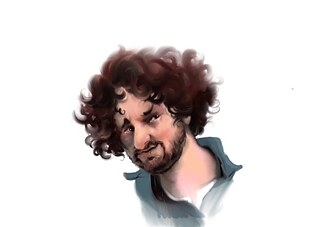
Real is not Real enough features the voice performance of Swiss actor Edgar Eckert, visual art by Eric Löbbecke | © Eric Löbbecke
Our special thanks go to Edgar Eckert. His energy and tireless effort during many hours of work made this project possible. Much of this happened during the 2021 lockdown in Sydney via Zoom and many other digital intermediaries that allowed us to forget the distance between Australia and Berlin (a collaborative, stereoscopic process that Anders would no doubt have had much to say about. With technology, we also linked up to Washington D.C., where Veronica Faust has our heartfelt gratitude for recording the introductory notes.
Jacob Craig’s sound design and brilliant musical compositions transformed the raw recording of the audio tracks into the immersive sonic experience we had hoped to achieve. And as Anders was a great believer in the power of humour and caricature, it is a special honour that Eric Löbbecke kindly agreed to create the title image for this project, the video trailer, and all the visual elements adorning the landing site.
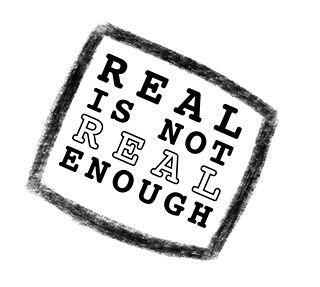
Finally, we’d like to thank the many partners and supporters who made this project possible, and give special thanks to the following individuals: Sonja Griegoschewski, Jochen Gutsch, and Caro Siegl from the Goethe-Institut Sydney; Katharina McGrath and Silke Schoppe from the German Academic Exchange Service, located in the DAAD's IC Sydney; Viktoria Wagner from the Austrian Embassy in Canberra; Jens Hoch from the German Embassy in Canberra; Jessica Milner Davis and Lindsay Foyle from the Australasian Humour Studies Network, the AHSN, in Sydney; and Leighton Bowers from the Western Costume Research Library in Los Angeles, California. Here, we would also like to dedicate some space to a special mention for the support of the Austrian National Library; our colleagues at The University of Sydney and Macquarie University; the publishing house C.H. Beck; Günther Anders' Literary executor Gerhard Oberschlick and FORVM; Christian Dries from the International Günther Anders Society; Jason Dawsey from the National WWII Museum in New Orleans; Christopher Paul Bush and Sorrel Dunn from the journal Modernism / Modernity; Jarrell Jackman in Los Angeles, California; tachles magazine; and the Leo Baeck Institute. A special thanks goes to Claudia Sandberg, Anna Pollmann, Bernd Bösel, Consuelo Martinez Reyes, and Tracey Cameron.
Sources
Der Aufbau/Reconstruction, “Corrections: The Acoustic Stereoscope“, 25 June, 1954, Vol20(26), Aufbau Archiv in der JM Jüdischen Medien AG, Zürich, Courtesy of the Leo Baeck Institute New YorkDer Aufbau/Reconstruction, “Letter to the Editor: Der Pionier des ‘Binaural’-Prinzip“, 21 May, 1954, Vol20(20), Aufbau Archiv in der JM Jüdischen Medien AG, Zürich, Courtesy of the Leo Baeck Institute New York
Günther Anders, “Caricartoons. A Suggestion for a New Type of Animated Pictures [um 1942/43]”, in Günther Anders, Schriften zu Kunst und Film, ed. by Reinhard Ellensohn and Kerstin Putz (Munich: C.H. Beck, 2020), pp. 73-83
Günther Anders, “The Acoustic Stereoscope”, Philosophy and Phenomenological Research, Dec 1949, Vol10(2), 238-243
Günther Anders, “The Émigré” [1962], trans. Otmar Binder, The Life and Work of Günther Anders: Iconoclast, Philosopher, Man of Letters, ed. Günter Bischof, Jason Dawsey, and Bernhard Fetz (Innsbruck: Studien Verlag, 2014), 171-186
Günther Anders, “Washing the Corpses of History”, trans. Christopher John Müller, Modernism/modernity PrintPlus 5(4)
Reinhard Ellensohn, “Nachwort: Günther Anders und die Musik”, in Günther Anders, Musikphilosophische Schriften: Texte und Dokumente, ed. by Reinhard Ellensohn (Munich: C.H. Beck, 2017), pp. 336-380